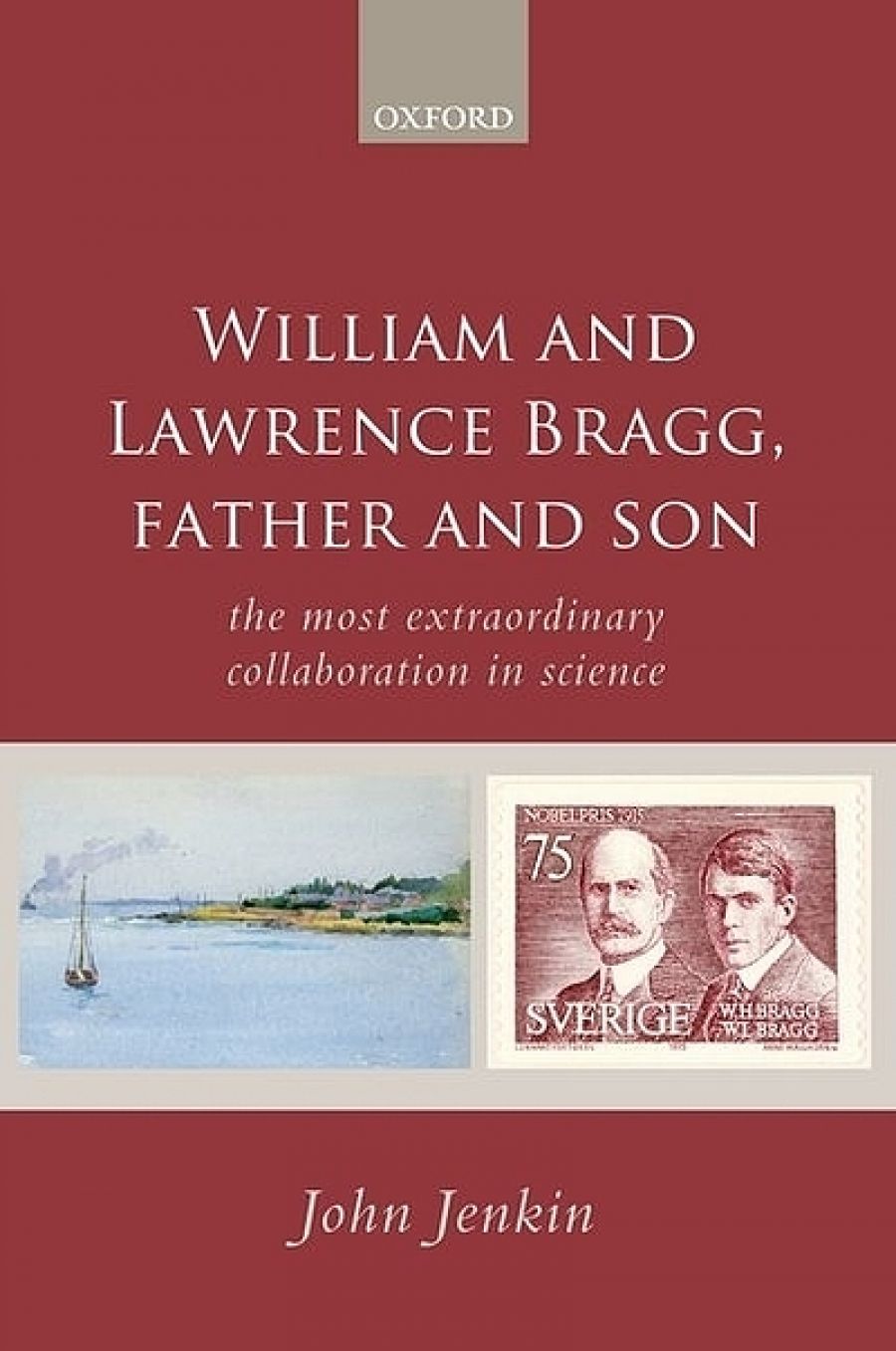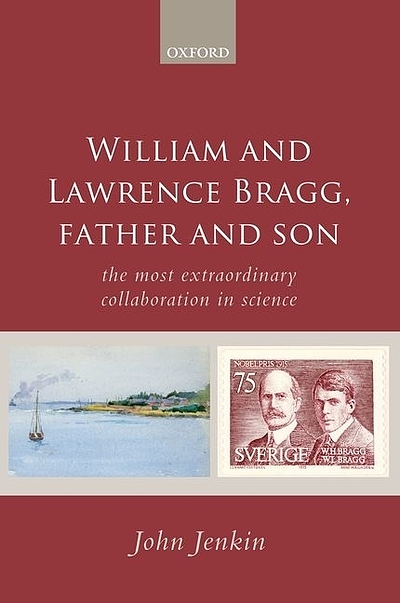
- Free Article: No
- Contents Category: Non-fiction
- Custom Article Title: The Book of Braggs
- Review Article: Yes
- Article Title: The Book of Braggs
- Online Only: No
- Custom Highlight Text:
The award of the 1915 Nobel Prize in Physics to William Henry Bragg, sometime Elder Professor of Mathematics and Experimental Physics at the University of Adelaide, and his Australian-born son William Lawrence Bragg is one of the icons of Australian science. Their ‘services in the analysis of crystal structure by means of X-rays’ is mentioned in the guide for new Australians, Becoming an Australian Citizen (2007), so we can put them up there with Don Bradman and Captain Cook.
- Book 1 Title: William and Lawrence Bragg, Father and Son
- Book 1 Subtitle: The most extraordinary collaboration in science
- Book 1 Biblio: OUP, $99.95 hb, 458 pp
- Book 1 Cover Small (400 x 600):

- Book 1 Cover (800 x 1200):

William Henry Bragg was born in 1862, in Cumberland, where his mother died before he was seven years old. He was sent to Market Harborough, in Leicestershire, to live with an uncle and his family and to attend the local school. From there he went to King William’s College on the Isle of Man, where he stood out on account of his academic and sporting prowess. Then it was on to Cambridge, where Bragg excelled at mathematics and also gained experience at practical physics in the Cavendish Laboratory. In the closing days of 1885, he was selected to succeed Horace Lamb in the Adelaide chair. He arrived to take up his new appointment at the end of February 1886.
Although mathematics was his strength, Bragg worked hard at his physics and eventually developed research interests that set the pattern for the rest of his life. Meanwhile, he married a local girl (daughter of Charles Todd, of transcontinental telegraph fame), raised a family and made significant contributions to the university, the School of Mines and the education of teachers. After spending 1898 on leave in Britain he returned to work on radioactive emissions, the charged particles known as α and β (later identified as helium nucleus and the electron, respectively) and then the uncharged X-rays and y-rays.
Late in 1907, however, Bragg succumbed to the Rutherford lure of proximity to leading researchers such as Ernest and J.J. Thomson, and accepted appointment at the newly fledged University of Leeds, where he took up his appointment in 1909. After building a department almost from scratch, with few staff and little money, in 1915 he moved to University College, London. Never happy there, he moved on to the Royal Institution, also in London, and held the directorship from 1923 until his death in 1942.
William Lawrence Bragg was ‘Willy’ in his earlier years but later adopted ‘Lawrence’, to distinguish himself clearly from his father and research collaborator. The eldest son, he was born in Adelaide in 1890, followed by Robert (Bob) in 1892 and Gwendoline in 1907. Like father like son, Lawrence enjoyed a brilliant school record and, after the family moved to England, excelled at Cambridge. During the Great War, he worked on the battlefields at ‘sound ranging’ as a means of pinpointing the locations of enemy guns, while his father aided the Royal Navy to detect submarines by means of hydrophones. Bob, a Cambridge student who joined the Royal Field Artillery, was killed in action at Gallipoli in 1915, as was the prominent young X-ray researcher Harry Moseley.
The work for which the Nobel Prize was awarded had its origin in experiments performed by Max von Laue, in Munich, who passed an X-ray beam through a crystal and observed ‘a number of very sharp, regularly arranged’ spots on a photographic plate. The Braggs learned about this in a letter from a Norwegian colleague; Jenkins notes that none of the many accounts of the great discovery mentions this letter, although Laue’s (later) formal publication is well known. William Bragg seems to have been blinkered by his uncertainty about X-rays – were they rays or particles? – but Lawrence had no doubts and quickly identified the phenomenon as one of diffraction as the X-rays were reflected from the planes of regularly arranged atoms that constituted the crystal. Diffraction of visible light was a well-known phenomenon, and the two collaborators soon worked out the theory and established ‘Bragg’s Law’ that linked the angle of incidence of the rays, their wavelength and the spacing of the atoms.
Lawrence succeeded Rutherford in the physics chair at Manchester, a game of musical chairs occasioned by Thomson's retirement from the Cavendish and by Rutherford’s move there. In 1937 Bragg left Manchester for the directorship of the National Physical Laboratory, but after less than a year the music started again upon the sudden death of Rutherford, and Lawrence moved back to Cambridge to head the Cavendish. Retiring in 1953, not long after the technique he had given birth to, X-ray crystallography, was used to demonstrate the structure of DNA, Lawrence became director of the Royal Institution, retiring again in 1966 but remaining in an honorary capacity until his death in 1971.
Many scientists were loath to give young Lawrence credit for the major part that he played in the discovery of the power of X-rays to unlock chemistry’s structural secrets, despite both Braggs drawing repeated attention to it. Jenkin ascribes this to jealousy but also notes that, neither stereotypical chemist or physicist, Lawrence lacked an automatically loyal cheer squad.
The professional relationship between William and his son went best when it was conducted in writing. Jenkin sums up Lawrence as an outsider, ‘socially inexperienced and naive and ... largely unaware of the subtleties of English social and academic practices and traditions’, never really accepted by the British establishment and always quiet conscious of his colonial origins. William, the father, was to the point of introversion, and never comfortable at Cambridge where… ‘clever talk alarmed him and smutty wit worried him’. He never went to Stockholm to give his Nobel address; Lawrence went belatedly in 1922, and he and his wife enjoyed the occasion immensely.
Edmund Gosse, in his memoir Father and Son (1907), described his relationship with his father, a religious fundamentalist and zoologist facing the inevitability of evolutionary theory, as ‘a study of two temperaments’. Edmund rejected his father and all he stood for, but later writers thought the old man was not so bad and that Gosse the younger, a poet and critic by trade, had taken some poetic licence. More recent has produced a counterpart in the 1970 Cat Stevens song for two voices, ‘Father and Son’. Guess which one said ‘how can I try to explain when I do he turns away again. It’s always been the same. I know I have to go’? Jenkin’s filial pair was often distant, never antagonistic, and he gives us great insight into their mutual relations and their interactions with their family (both had supportive wives and enjoyed the ambience of family), their students and their peers.
Reflecting on the gestation of his book, John Jenkin writes that he pursued the story on and off for more than twenty years. It was worth it.


Comments powered by CComment